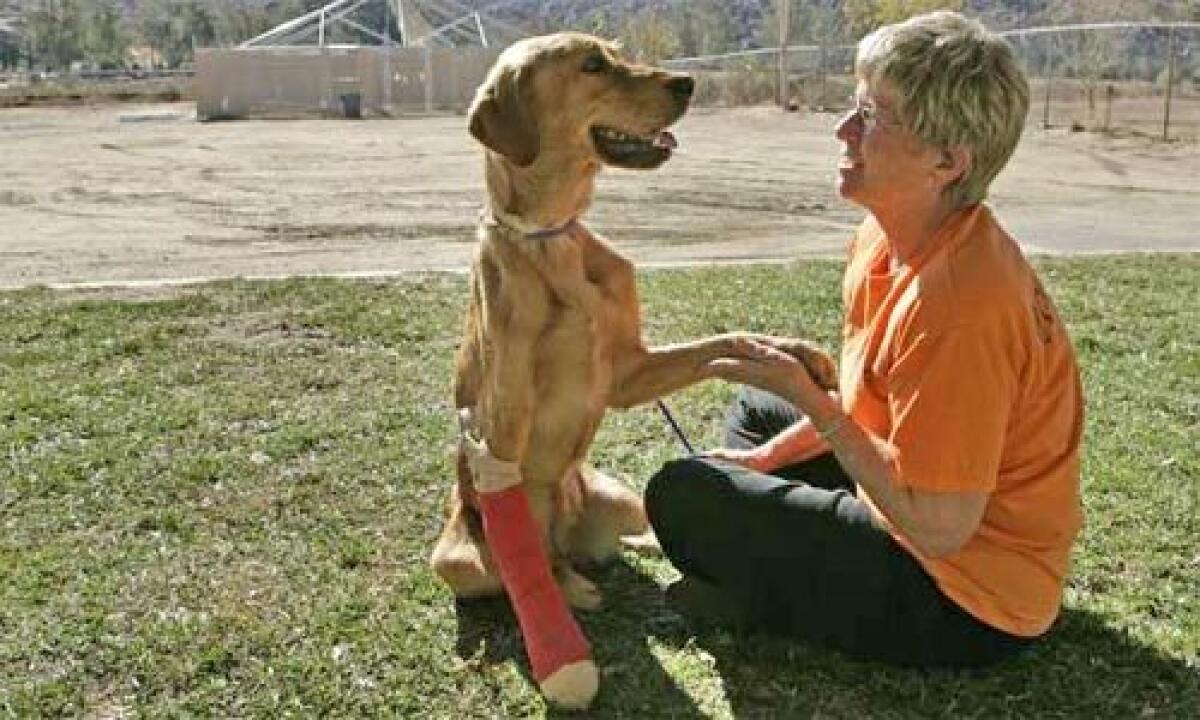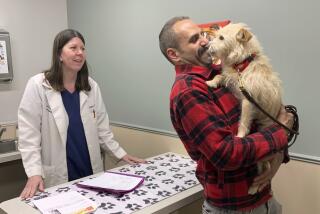Rescued dog fetches interest in adoptions

Her name is Oleander, and her freeway drama gripped the residents of Riverside County like few car chases ever could.
For two months, the golden retriever mix wandered a six-mile stretch of Interstate 10, surviving on little food and water, loping along on a broken leg. Frightened, she evaded the California Highway Patrol officers who tried to rescue her, weaving her way through the median strip’s oleanders -- hence the name given by her would-be rescuers.
As officers continued their pursuit -- even shutting down traffic a few times -- drivers, watching helplessly, called in to report sightings. When a patrolman finally coaxed the 3-year-old dog into his car, she was whisked to a Riverside County Department of Animal Services shelter in Banning.
The story was picked up by the local news media, and within two days of the announcement that the dog was up for adoption, the shelter received 90 phone calls from people wanting to adopt Oleander, foster her or give her money. Ten people claimed they were the rightful owners.
Oleander is one of thousands of animals at Southern California shelters, many of which will never be adopted. If she had simply been dropped off at the facility and lined up in a run next to dozens of other unwanted canines, she might be there months from now.
But with a compelling back story and generous news coverage, Oleander went from stray dog to media darling.
“Getting an animal on television is a guaranteed adoption,” said Ed Boks, the general manager of the Los Angeles Department of Animal Services, which runs six city shelters. “I think it has to do, perhaps, with an affinity with fame. A lot of folks want to touch that celebrity status through adopting the animal that everyone now wants.”
Jeff Blodgett, a spokesman for the Society for the Prevention of Cruelty to Animals Los Angeles, said some people don’t know where or how to adopt until they see how on TV or in newspapers, or become motivated to adopt only after they know the animal’s story.
“What grabs the most attention and brings awareness to pet adoptions are the cruelty cases,” Blodgett said. “A dog or cat that has been abused generates a lot of sympathy.”
Boks said dogs and cats that have not been adopted for months will sometimes prompt as many as 150 calls once they are shown on TV, depending on how sad their story is -- or how cute they are. (Oleander’s 90 calls were much higher than the normal 12 to 50 inquiries for a pet featured in local Riverside County media.)
Consider the story of Spike, a small male Chihuahua mix available for adoption from SPCA Los Angeles. He’s been adoptable since August, but on Wednesday, after a 30-second segment on Fox 11’s morning news show featured Spike, about 20 people called in asking about the dog, shelter staffers said.
There’s a deliberate methodology behind which animals make it as media stars and those that don’t, area pet adoption officials say.
“It’s the cute factor,” said Denise Jakcsy, senior director of companion animal services for the Society for the Prevention of Cruelty to Animals of Los Angeles. “That’s what grabs people’s attention first -- how the animal looks.”
In addition to “cuteness,” adoption officials at local shelters said they look for animals that have lighter coats because the pets will look better on camera. They also opt for those that are well-behaved and those that have been in the shelter the longest. Pets that are disabled or diseased need not apply.
“As in the case of real estate and advertising, a pet being adopted sort of depends on how it is portrayed in the media,” Boks said. “You don’t want one that’ll jump off the news desk or attack a newscaster.”
The pets that don’t do as well on TV segments are those with dark coats -- and pit bulls.
“You can’t even see the dogs with darker coats sometimes in the kennel, and they’re pretty nondescript,” said Lori Neddermann, adoptions chief for the Riverside County Department of Animal Services. “And if people hear ‘pit bull,’ they tend to think it’s a negative connotation. It makes it much harder to get people to pay attention to them.”
Once a televised animal stirs up interest from the public, shelter officials say, they typically try to shift attention to other pets in dire need of adoption.
In August, Orange County Animal Care Services inherited 75 animals seized from a Santa Ana pet shop after authorities found them in 101-degree temperatures with unclean water. The calls poured in, and a month later, when the seized pets -- 50 puppies, six kittens, 18 rabbits and a guinea pig -- went up for adoption during a publicized event, each one went to a new home. But another 40 dogs and cats at the shelter got new homes as well.
“We tried to take advantage of the moment you have all this attention,” said Ryan Drabek, a spokesman for the Orange County agency. “From our perspective, it’s using a bad situation, like the seizing of the animals, to turn it around for something for the greater good.”
With tens of thousands of dogs, cats, rabbits and exotic animals up for adoption throughout Southern California every year, only a few hundred get the star treatment in those “adopt-a-pet” segments that have become staples in local television programming.
Boks estimated that last year about 250 of the city shelters’ 21,820 adopted animals were featured on weekly television segments on networks such as KABC-TV Channel 7 and local cable Channel 35’s Home Shopping Petwork.
“The hardest part for us is choosing which animal’s story you don’t tell,” Boks said.
Oleander fit the “media darling” description perfectly: She resembled a well-known breed, was well-behaved and was photogenic with her vibrant auburn short-hair coat. And her predicament was bound to tug at any animal lover’s heartstrings.
When captured, Oleander weighed 34 pounds -- 20 pounds underweight -- and had a broken right leg that will require about $5,000 in surgery. She had no identification such as a license tag or microchip.
To determine Oleander’s rightful owner, shelter staff interviewed each of the 10 callers and was able to narrow down a match to a family in Banning who had license paperwork and a believable story about how their dog jumped the fence and got lost during a storm. Oleander and her owners are expected to be reunited this week, but only after they locate a veterinarian for surgery on her leg and promise the county they will finance the procedure, said John Welsh, a Riverside County Department of Animal Services spokesman.
“Turns out her real name isn’t Oleander; it’s Precious,” Welsh said.
When more than one person wants to adopt an animal whose ownership cannot be determined, shelters will sponsor a raffle or lottery, Boks said. Sometimes people adopt pets similar to the publicized animals that staffers recommend, but not always.
“One more thing I have seen, that is endemic in the industry, is that when an animal is featured on TV, everyone will want that animal and no other will satisfy them,” Boks said.
francisco.varaorta @latimes.com
More to Read
Start your day right
Sign up for Essential California for news, features and recommendations from the L.A. Times and beyond in your inbox six days a week.
You may occasionally receive promotional content from the Los Angeles Times.






